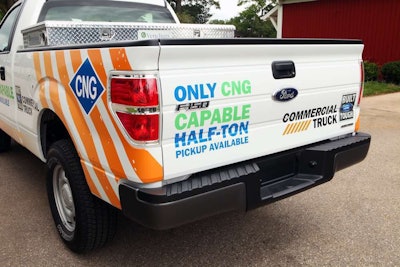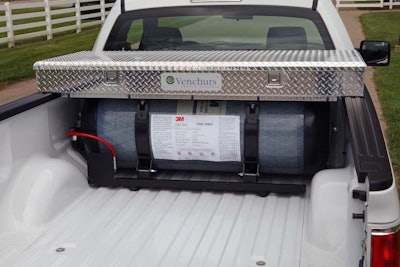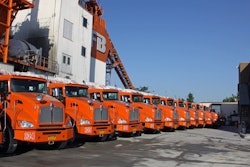
To answer your question and a few more of our own, we sat down with Ford’s Dick Cupka, the automaker’s product development sustainability manager for commercial vehicles, and learn more about these new trucks.
The Ford factory in Kentucky puts these trucks out with upgraded materials for the valves and valve seats, anodized pistons and a special piston ring set, Cupka says. Then they’re shipped to one of the company’s seven Qualified Vehicle Modifiers for installation of the fuel tanks and lines. From there they go to the Ford dealer and the customer.
The factory gas fuel prep package only adds $315 to the total. The rest of the upcharge, anywhere from $7,500 to $9,500 goes into the fuel tank. As with any natural gas vehicle, the money’s in the specially designed tanks to handle the pressurized fuel.

You can spec a tank for one or the other but not both gaseous fuels in the same truck. LPG (propane) stores as a liquid at a relatively modest 500 psi, whereas CNG requires a tank that can hold 3,600 psi.
Customers spec their fuel tanks according to what fuel is most prevalent in their area. Propane is widely available, and runs about $2.15 per gasoline gallon equivalent. But in areas where there is a lot of natural gas infrastructure, CNG might be the better choice, Cupka says. In Oklahoma City, he says, CNG is selling for 79 cents per gasoline gallon equivalent. Yeah!
You should also look at tank weights and payload capacity. The greater your need for payload, the more you’ll want to consider a lighter weight tank.
And while you can’t use two gaseous fuels in one truck, you can spec your truck to run on one of these fuels plus gasoline. “We’ve got a ton of people working on bi-fuel, gasoline-CNG right now,” Cupka says. “We don’t have anybody working on bi-fuel propane-gasoline. It’s possible but they’re not doing it right now. “
The reason customers spec the bi-fuel option is that they can run the truck on low-cost CNG most of the time, but if they run out and can’t find a CNG refueling station they can switch to the gasoline fuel system and run on that until they have a chance to refill the CNG tank. The transitions between fuels on these types of trucks is seamless.
CNG and LPG are both very clean fuels and as such you don’t need different lube oil or filters. Cupka says the service intervals for these are the same in the CNG and LPG trucks as they are for regular gasoline burning F-150s. Some upfitters put a coalescing filter on the fuel line that drains out moisture and sediment, but those typically have a six month, 15,000 mile drain interval, he says.
If you’re a mechanic or fleet manager or do the maintenance on the trucks in your construction fleet, there are a few things to be aware of. These include:
-
Your fuel tanks need to be inspected every three years by a qualified person for safety purposes. If you don’t have a person qualified to do these inspections, your dealer can help you with this.
-
As with any pressurized system, gaseous fuel can be dangerous if you are working on the system and fail to bleed off the pressure before removing components. “There are special safety precautions you take to make sure you are eliminating pressure on the line or valve or whatever, before you remove components,” Cupka says. All the manufacturers have a specific instructions on shutting off the fuel tank and bleeding pressure from the system, so make sure you follow these. Fortunately you can do most routine maintenance, including replacing spark plugs, without having to access the pressurized fuel system.
-
Ventilation and electrical requirements and permits for shops set up to work on gaseous fuels are typically different from the requirements for liquid fuels. Consult with your local building and fire code officials before you set up to work on a CNG or LPG system.
-
Think about refueling in the shop. If you drain the fuel tank completely in the shop, you’ll need a source of that fuel at hand to get the truck restarted (unless its’ bi-fuel with the gasoline option). Cupka says shops like this typically keep some gaseous fuel in tanks on a cart nearby. These provide enough fuel to start the truck after repairs and get it to a refueling station.
-
Be careful about flashing and calibration. The calibration codes in the powertrain control module are proprietary to each truck’s installation, Cupka says. The VIN numbers are entered into Ford’s online information system identifying that truck as a natural gas model. So anybody working within the Ford system should see and note this so they don’t overflash the calibration. But if somebody were to make a make a mistake and flash the wrong calibration, it won’t run right, he says.














